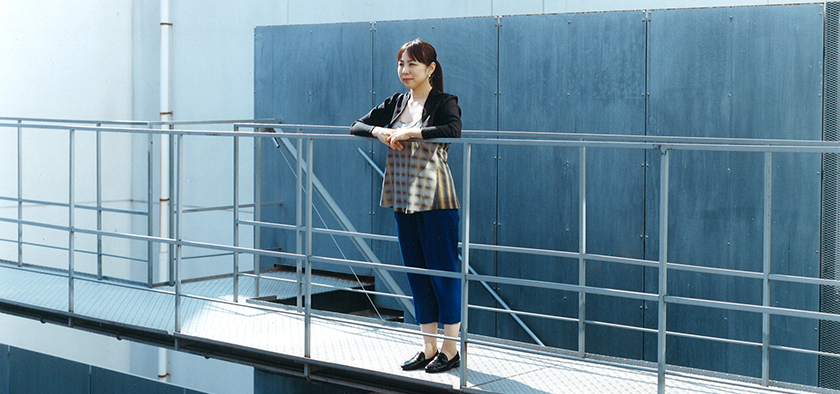

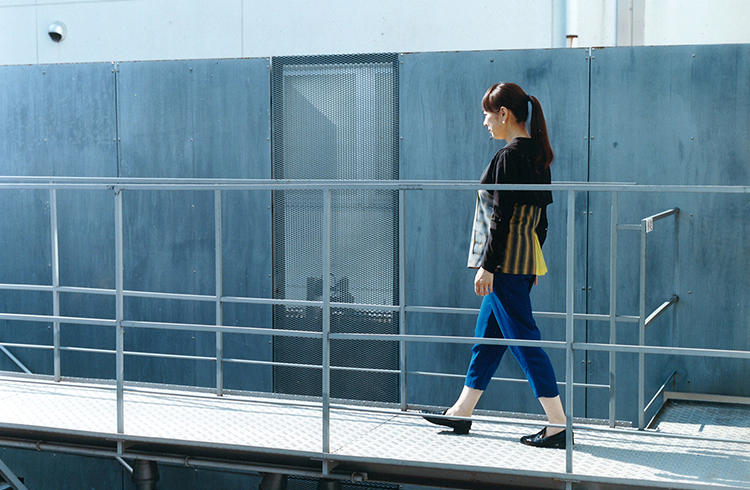
How would you turn Roppongi into an area of Design & Art?
Use existing places in more interesting ways
- JP / EN
Yuko Nagayama has caught attention as a woman architect who is in demand both in Japan and abroad. While known for designing glamorous commercial architecture like the Louis Vuitton Kyoto Daimaru store, Nagayama has recently been engaged in numerous renovation projects and is also putting her energies into launching art events. Her favorite place in Roppongi is "TOTO Gallery Ma" which specializes in architecture and design; she told us that she often visited the art gallery as a student to see the exhibitions by architects she admired. We asked Nagayama what she would do to turn Roppongi into an area of design and art.
Use the town itself as a place for expression
Roppongi has art museums and facilities specializing in design, and these places for art do have the effect of drawing the people who are interested in art and design. But I think it would be more interesting if the town itself could be used as a place for expression and if we could clearly see the artists in action.
For example, the wall of a large building could be made available to artists as a canvas, or perhaps a garage-like place could be offered to artists. I think the important thing is to have an actual place for creation in Roppongi, and for people to be able to feel that the area and art are moving together.
This does not mean that new facilities need to be built; it means using the places we have now in more interesting ways. There are many buildings whose back walls are undecorated; these are part of the town's scenery. Even if only small parts of each building could be offered to the artists, the scenery of the town will begin to change if each building offered more parts and if a network could be established.
From renovation work to AT ART UWAJIMA
Talking of using existing places in interesting ways, there will be a month-long art event called "AT ART UWAJIMA" from July 24 in Uwajima City, Ehime Prefecture - a city that faces the Seto Inland Sea. I got involved in this because I was engaged last year in the renovation of "Kiya Ryokan", a traditional Japanese inn in Uwajima. This was a project to transform an inn with a history of almost 100 years into a conceptual accommodation facility that caters to one customer per day. From the beginning, I wanted the inn to be used not only for accommodation, but for many cultural events and events related to the region.

AT ART UWAJIMA 2013
A project started by the initiative of Yuko Nagayama and artist Akira Fujimoto with the aim of using art to energize Uwajima, Ehime Prefecture. For the first part of the project, art works will be installed for a month starting July 24 in Kiya Ryokan and in the city's shopping arcade. Seven artists are participating in the project, including contemporary artist Tabaimo, manga artist Yoriko Hoshino and members of SIDECORE.
http://www.uwajima-soen.com/
On the Teshima Island in the Seto Inland Sea, I am currently involved in the "Teshima Yokoo House" - a project to renovate a "minka" (traditional Japanese house) into an art museum for the artist Tadanori Yokoo. Through this project I have witnessed how art can be used to regenerate a region by taking the whole region into account; it really made me see how art can change a region. So we thought about the things that could be done in Uwajima, and we began planning art events that are not limited to "Kiya Ryokan" but which take place all over the city of Uwajima.
New appeal given by art
Uwajima has a grand shopping arcade. It also is the home of the famous "Ushi-oni Festival" which is a parade of big floats of creatures 5-6 meters high that look like lions from the "shishimai" lion dance. The huge arcade where the "Ushi-oni" floats pass by will be the venue for our upcoming exhibition. There is a stationery store that is going to be shut down, and we are planning to use that store and the vacant lot next to it for art installations.
What has been interesting for me personally is that by putting my energies into the "AT ART UWAJIMA" project, I can now spot all kinds of places that have potential; before, I probably would not have noticed them. Art can give new appeal to a place. This is also true for the walls of large buildings in Roppongi that I mentioned earlier. The place can also be an empty piece of land that has been left neglected for a long time, or a tiny niche-like space. If the exhibition venue changes, it would change the motivation of the artist; by setting the stage in a place that is different from everyday life, new ideas will be born.
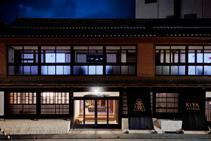
Kiya Ryokan
An accommodation facility in Uwajima City, Ehime Prefecture, offering experiences in art and entertainment. It was formerly an old inn that had closed down; now it has been reborn as an artistically renovated facility with an atmosphere of relaxing "un-attendance". Yuko Nagayama designed the architecture and the work led her to starting a regional revitalization project in Uwajima. Many kinds of plans are underway to link artists with the local people.
URL:http://kiyaryokan.com/

Collaboration with artists and the skills of the architect
As an architect, I have an interest in what happens to my creations in the future: how the architecture will be used, how it will be maintained, or how it will be changed. I don't want to just make something and end there; I want to propose how my creations could be used after their completion. Even with places I have not made, I like to make suggestions in the same way if they are very interesting.
I'm also interested in collaborating with artists. I feel that instead of making something by oneself, many new possibilities can be opened up by creating a space with another person. An architect is an expert at looking at places: he or she is capable of discovering hidden potential in existing spaces, and can give specific ideas for solving problems. As for the current project I'm engaged in, I can immediately come up with solutions concerning structure because I have a good understanding of what the project is about. For example, I know that holes can be drilled into a certain wall when it turns out that we need to use a projector. I can be consulted on a whole range of issues and respond quickly to all kinds of needs such as calling a carpenter and having the power source fixed in a certain place. Through renovation work I have learnt how to "reread" the current circumstance of a place. I've come to think that in the future, the skills of an architect will include the ability to make proposals: the architect may not need to actually make anything, but could suggest that someone do so-and-so to make the place more interesting or suggest the elements that could be brought to a place to give it new life.
Architects and landscape gardeners in Tokyo Midtown
I think there is a lot of potential in Roppongi to create venues with many different people. If some space is available in Tokyo Midtown, perhaps it might be a good idea to ask landscape gardeners to do something with it, rather than artists. If you collaborate with craftsmen and people who may not be artists by profession but who have creativity, and who have the ability to look at a place with new eyes, I think you will get more interesting ideas.
The important thing when undertaking such projects is to be conscious of the people who will come to the place. The ideal is to offer something to not just the people who are interested in art, but to the people of the region and people who have not appreciated art before. Art is not just about looking at a work and enjoying it; I think art is something that gives the viewer a new perspective, a personal discovery. A very ordinary person could encounter art in everyday life and see something in a different way from before. This element is something I try to keep in mind when making architecture; I want people to become aware of things they would not usually be aware of - such as the change of the seasons perhaps; it is my hope that the spaces I create prompt awareness of something.
Being attentive to pure viewpoints
Several times in places such as Uwajima and Teshima I've had the experience of hearing old people - grandmothers and grandfathers - make very sharp, insightful comments on artwork even if they have not seen much art before. When the Teshima Yokoo House was still in construction, we invited the local people to take a look around, and we got some very helpful comments - the people have a very pure way of looking at things.
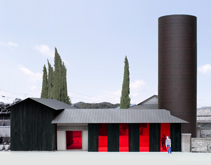
Teshima Yokoo House
Artist Tadanori Yokoo's new art museum to be opened in Teshima Island, Kagawa Prefecture this summer to coincide with the Setouchi Triennale 2013. Yuko Nagayama designed the art museum which was made from renovating a "minka." The various stages of its construction have been shown to the general public, and the museum has already attracted attention before its opening.
Sometimes, people say unexpected things. Their interpretations may not be quite what we intended to convey, but that's okay because those perspectives are interesting too. (laughs) Since they don't have preconceived notions, they look at things in a straightforward way. I want to pay as much attention as possible to these viewpoints and that's why I'm motivated to create places that will draw all kinds of viewers.
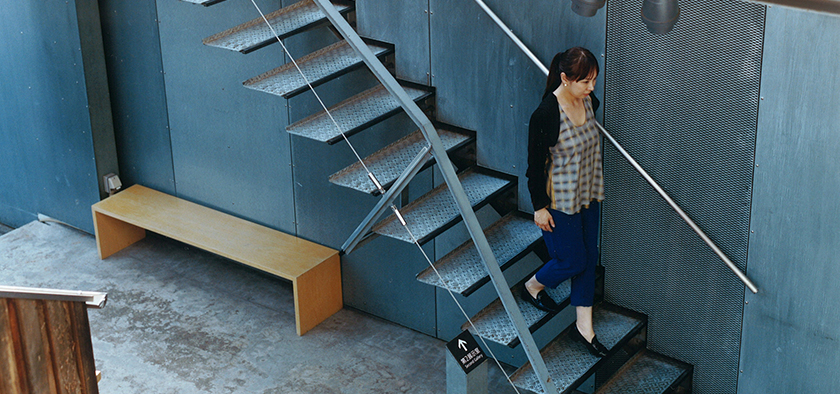
Learning about Tokyo by taking the outsider's perspective
Besides Tokyo, the city I visit most often is Kyoto; I like how it is compact and organized. In comparison, Tokyo is huge and sprawling, expanding so much that it's difficult to tell where the boundaries are. Before, I didn't think this was an attractive aspect of Tokyo, but recently, I've come to think that it's interesting.
I'm currently involved in planning an exhibition comparing Paris and Tokyo, and this project has made me realize a few things. For example, a French person said to me, "Unlike Paris, Tokyo has a landscape, doesn't it?" I thought, "Landscape? What landscape?" and then the person said, "You can see Mount Fuji in the distance." That comment made me remember that all over Tokyo there are places called "Fujimizaka" (Mount Fuji viewing slopes) and that there are many hilly spots with a fine view.
I was also told that "there is a lot of greenery in Tokyo." When I asked what exactly that meant, it turned out that the "greenery" was about the small pots of plants which people place outside their front doors.
The blurry boundaries in public spaces
The way that these pots of plants owned by individuals are protruding onto the streets is apparently interesting to the French people. In the stone streets of Paris which have a uniform look, it is definitely not common to come across a pot of plant belonging to someone. The French really notice the peculiar things in Tokyo. For instance, they look at the PET bottles lined up to keep the cats away, and ask "What on earth is that?" (laughs)
You would never find those mysterious PET bottles filled with water in the streets in Paris or in any other European city. They would probably be removed. In Tokyo, though, a kind of tolerance exists. I realized that the (public and private) boundaries are sort of blurred and that this is one of the characteristics of Tokyo.
Attractiveness in the things we take for granted
The French also found intriguing the different scales of buildings - the fact that tall buildings stand along a big road, but one street behind, there are low residential houses. In Tokyo, due to city planning regulations, there are residential houses that are distanced from the road and there are also roofs that are cut at a slant, but these things are interpreted (by people outside of Tokyo) as being part of the intended designs. The other day, I was explaining to an architect from Miami that a certain line in the architecture was due to regulation, but the architect insisted that the design looked good that way. I heard once that in Thailand there used to be buildings cut at a slant; there was no need for them to be like that, but they were perhaps inspired by Japanese designs.
For people outside of Tokyo, this city has very strange sights and characteristic designs which we take for granted. If we can take a good look at each one of these things and recognize that they form the unique appeal of Tokyo, I think our involvement with the city will change, and there will be greater potential for the streets to become more attractive.
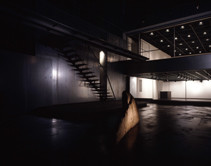
TOTO Gallery Ma
An art gallery operated by TOTO Ltd., which specializes in architecture and design. The exhibitions are planned by special advisor Tadao Ando and members of the management committee comprising Waro Kishi, Hiroshi Naito, Kenya Hara and Erwin Viray. Established in 1985, the gallery has held free exhibitions for the public on Japanese and overseas architects and designers.
1-24-3 TOTO Nogizaka Building 3F
Minami Aoyama Minato City, Tokyo 107-0062
URL:http://www.toto.co.jp/gallerma

The school trip exhibition of five creators
An exhibition to mark the event held in Tokyo Midtown in September 2009 for the launch of the "Discover Japan" magazine. Kyoto was the theme of the first issue of the magazine, and this exhibition shows the fascinating aspects of Kyoto as seen through the eyes of five creators. The venue was designed by Yuko Nagayama.
Editor's thoughts
It was enthralling to hear Nagayama-san talk about the art projects in Uwajima and Teshima. I could imagine how art would blend in with everyday life in the islands of the Seto Inland Sea and felt envious of the people living there. I think that Tokyo too needs to have the same sort of sensitivity and openness toward art which the residents of Uwajima and Teshima have shown. I hope to make a visit to the Setouchi Triennale this summer.(edit_rhino)



















